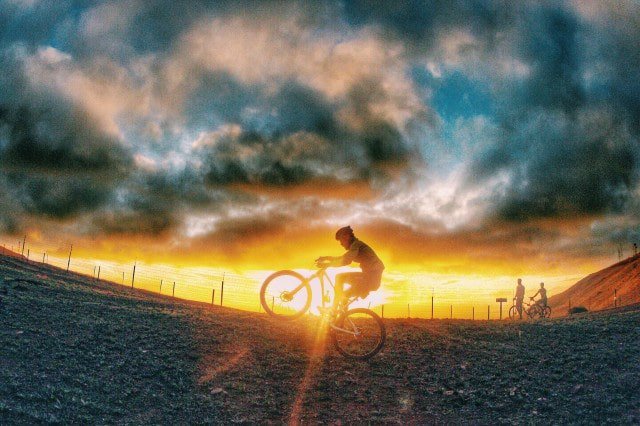5 Ways to Be a Better Fat Burner
These strategies can help you burn more fat on and off your bike.
These strategies can help you burn more fat on and off your bike. – By Selene Yeager
 There are a few obvious benefits of being a better fat burner: You shed unwanted padding and reap the related health benefits, including a lower risk for metabolic and chronic diseases like heart disease and diabetes. But even if you’re lean, improving your fat burning capacity will help you ride better because tapping into your nearly limitless fat stores increases your endurance and reduces the likelihood of bonking on long rides.
There are a few obvious benefits of being a better fat burner: You shed unwanted padding and reap the related health benefits, including a lower risk for metabolic and chronic diseases like heart disease and diabetes. But even if you’re lean, improving your fat burning capacity will help you ride better because tapping into your nearly limitless fat stores increases your endurance and reduces the likelihood of bonking on long rides.
“You’ll also feel better,” says two-time Olympic coach Gale Bernhardt, co-author of Become a Fat-Burning Machine. “When cyclists train themselves to burn more fat, they enjoy more-even energy levels on their bike and they don’t need to eat so much to fuel their rides.” Here’s what she and others recommend.
Add a few hard intervals.
To maximize your fat burning capacity, Bernhardt recommends doing what she deems “miracle intervals” once or twice a week (but no more). These are very short 10- to 30-second max effort intervals with complete recovery between them. Combined with regular endurance training, research shows this type of very high intensity interval training (HIIT) increases your maximum oxygen consumption, raises your lactate threshold, and improves your cycling economy, all of which allow you to stay “aerobic” longer, so you can burn more fat at higher intensities. You need a fitness base to do these, so if you’re a true beginner, have a few months of cycling under your belt before working these interval workouts into your routine.
Here’s a sample “miracle interval” workout:
• Warm up for 20 minutes at an aerobic effort
• 3 x 30 seconds all-out power production, 4:30 easy Zone 1 spinning
• 3 x 20 seconds all-out power production, 4:40 easy Zone 1 spinning
• 3 x 10 seconds all-out power production, 4:50 easy Zone 1 spinning
• Cool down with easy spinning
Respect your recovery.
Remember hard training only works if you allow your body to recover. You need easy rides and days off, too, says Bernhardt. “The biggest mistake I see riders making is they’re going hard too often—sometimes every day,” she says. In that situation, fatigue blunts all those adaptations that make you a better fat burner. In any given week, Bernhardt recommends doing no more than three rides that are very stressful, whether that’s intervals, a hammerfest group ride, a hard hilly ride, or a very long ride.
RELATED: Recovery Food You Should Eat After a Hard Ride
Remember, too, to get adequate sleep. Sleep is when your body repairs and fully recovers. Plus, research shows that skimping on sleep slows your metabolism, which is obviously not beneficial for fat burning, and leads to weight gain.
Do a couple coffee rides every week.
When glycogen stores are low, your body is forced to pull from your fat stores, which is why pro cyclists have sworn by fasted rides for ages. It’s easiest to do in the morning. Once or twice a week, have some black coffee, which encourages the release of fatty acids into your bloodstream and go for your ride, saving breakfast for when you get back. “If you’re going to ride more than an hour and a half, take food with you and start eating after about an hour and fifteen minutes,” says Bernhardt.
Some research suggests that doing hard efforts in a fasted state boosts your fat-burning adaptations even more. So if time is short, you can get up, bang out your miracle intervals, eat breakfast, and be on your way.
RELATED: Should You Ride Hungry?
Eat more fat. Low-fat is officially dead.
And if you want to be a better fat burner, eating more fat helps, especially if you eat more über-healthy omega-3 fatty acids from fatty fish, nuts, and avocadoes. Research shows that these fatty acids activate receptors in your digestive tract that improve your fat-burning metabolism. Bernhardt personally recommends getting as much as about 50 percent of your daily calories from fat. “I find when my athletes eat a high percentage of calories from fat, they only need about 70 to 100 calories an hour on their bike. It doesn’t happen overnight. You need to give your body several weeks to adapt before you feel really good during key workouts.”
Skip the energy foods for short rides.
Yes, even fat-burning machines need to fuel up during long and/or hard rides and competitions. But too many riders eat too much, taking bars and drinks before, during, and after every ride, blunting their fat burning and in some cases actually packing on pounds. For rides less than an hour, leave the sports drinks and bars at home.
READ MORE ON: lifestyle nutrition weight loss

